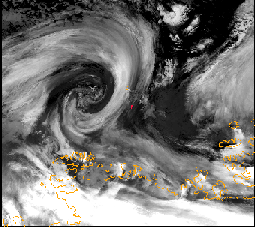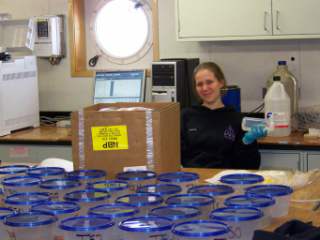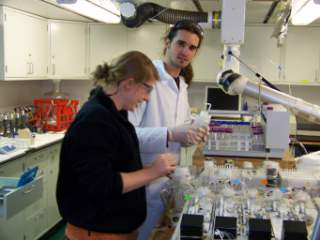Location: Drifting in the pack ice in the Bellingshausen Sea.
Latitude: 70° 38′ S Longitude: 92° 13′ W Air temperature: -13.9 °C (7.0 °F) Wind chill: -42.9 °C (-45.2 °F) Water temperature: -1.7 °C (28.9 °F) Relative humidity: 74.8% Barometric pressure: 936.8 mBar
Antarctic trivia (answer at the end of this journal entry): Who was the Bellingshausen Sea named after, and what was his Antarctic claim to fame?
A team strategy-planning meeting and weather-watching were the main activities today. We arrived at our drift station location yesterday afternoon and were looking forward to starting our ice work today, but Mother Nature clearly had other plans for us. We awoke to cold temperatures, swirling snow, and intense winds. Sustained wind speeds throughout the day were recorded at 50 to 60 knots (58 to 69 mph), with gusts up to 70 (81 mph) knots. As a comparison, tropical storms become hurricanes when the sustained winds reach 65 knots, so the winds we experienced were close to hurricane strength.
 NOAA satellite image from 9/25. The ship’s position is indicated by the red symbol.*
NOAA satellite image from 9/25. The ship’s position is indicated by the red symbol.*
The image above is a NOAA (National Oceanic and Atmospheric Administration) satellite image from two days ago. If you look carefully you can see the ship’s position indicated with a red symbol. The intense weather we are experiencing today is the result of the low pressure system pictured in the image. The system moved slowly to the southeast, directly over current our location. The barometric pressure was extremely low; many people experienced ear aches due to the storm. (This is similar to what you experience when you change elevation rapidly, such as during take-off or landing in an airplane, but not so intense!). Temperatures dropped throughout the day, leveling out at a chilly -13.9 °C (7.0 °F) with a wind chill of -42.9 °C (-45.2 °F). We have had unusually good weather this trip, so we took the bad weather in stride and looked forward to starting our work on the ice tomorrow.
The science team made the most of the enforced inside time to build or test equipment and catch up on lab work. Analysis of snow and ice samples for our three in-transit stops is ongoing.
 So many containers! Florence prepares bottles and containers for snow and ice samples.
So many containers! Florence prepares bottles and containers for snow and ice samples.
 Ever the clown, Martin entertains Beverly while they work the nutrient analyzer.
Ever the clown, Martin entertains Beverly while they work the nutrient analyzer.
That’s all it for now, let’s hope the wind dies down, the weather warms, and the snow stops blowing!
Try this: Look at the weather map in the newspaper or online (try www.weather.com) for your area. Do you know what the symbols mean, and can you predict from the map what the weather might be like in your area tomorrow or for the next few days? Try not to "cheat” and read the forecast, really study the map and see if you can figure it out, then compare your prediction to the meteorologist’s. Check out what the weather is like in another part of the world. It’s interesting to compare cities that are at the same latitude but on different continents. Would you predict that they would have similar weather? What about at the same latitude, but in the opposite hemisphere…if you are at 30°N, what’s it like at 30°S?
**Answer to today’s Antarctic trivia question: **Who was the Bellingshausen Sea named after, and what was his Antarctic claim to fame?
Captain Fabian Bellingshausen was a Russian explorer who is arguably the first person to sight the Antarctic continent in 1820. There is some disagreement as to who really saw the continent first; you might remember a previous trivia question in which I told you Nathaniel Palmer was the first! Since I’m living on a ship named after Captain Palmer, I think I’ll side with him!
Marine mammals and sea birds spotted today by Brent: Conditions were so bad today that no birds or mammals were able to be spotted from the ship, in fact ice formed on the inside of the windows of the "ice tower” observatory that Brent uses for observations!

